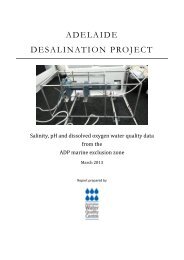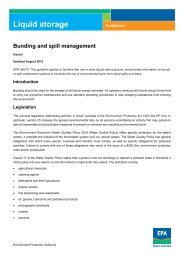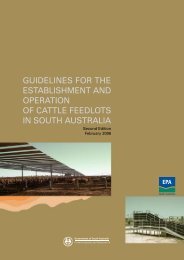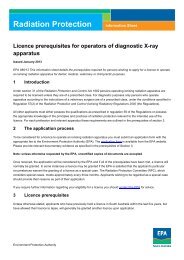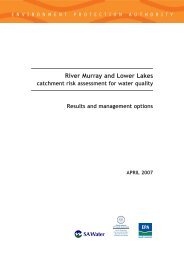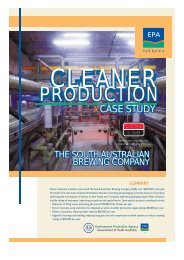Commercial Chicken Farms and Processors - EPA
Commercial Chicken Farms and Processors - EPA
Commercial Chicken Farms and Processors - EPA
You also want an ePaper? Increase the reach of your titles
YUMPU automatically turns print PDFs into web optimized ePapers that Google loves.
Review of On-Farm Disposal Treatment Risks <strong>and</strong> the Potential for Recycling of Wastes<br />
Produced from <strong>Commercial</strong> <strong>Chicken</strong> <strong>Farms</strong> <strong>and</strong> <strong>Processors</strong><br />
surface, <strong>and</strong> stormwater protection measures to prevent the potential pollution<br />
of surface water or groundwater.<br />
26. Where bins are required to be collected from the edge of the farm property, they<br />
should not be placed at the edge of the property any earlier than twelve hours<br />
prior to the scheduled collection time.<br />
On-site composting of chicken farm waste<br />
27. Composting, using aerobic systems such as the purpose built rotary composter<br />
or bunker system as shown in Appendix G, is recommended. An aerobic<br />
environment should be maintained in the compost to prevent the emission of<br />
unpleasant odours.<br />
28. The composting site should be on an impervious surface, <strong>and</strong> have roofing to<br />
prevent water from leaking into the compost.<br />
29. Stormwater run-off should be diverted around composting areas by drains, bund<br />
walls, or by shaping the ground to ensure that stormwater does not pollute<br />
surface water or ground water.<br />
30. The site for composting should be as distant from sensitive l<strong>and</strong> uses as possible<br />
to minimise loss of amenity by adjoining l<strong>and</strong> owners.<br />
31. The site for composting should be as far from surface watercourses as possible.<br />
32. The use of composted material on-site should be as distant from sensitive l<strong>and</strong><br />
uses as possible to minimise loss of amenity by adjoining l<strong>and</strong> owners.<br />
33. All new composting works must obtain appropriate development approval<br />
under the Development Act 1993. Composting activities are classified as either<br />
Schedule 21 or Schedule 22 development, depending upon the volume of<br />
compost being produced per year.<br />
¢ Schedule 21, Development Regulations 1993, 5(3) Composting, Organic<br />
Fertiliser <strong>and</strong> Soil Conditioner Works: the conduct of works at which<br />
mushroom <strong>and</strong> other compost, organic fertiliser or soil conditioner having<br />
organic components are produced or are capable of being produced at a<br />
rate exceeding 20 tonnes per year; or<br />
¢ Schedule 22, Development Regulations 1993, 6(3) Composting Works: the<br />
conduct of works at which mushroom or other compost is produced or is<br />
capable of being produced at a rate exceeding 200 tonnes per year.<br />
On-farm disposal of chicken farm waste<br />
34. On-farm disposal of dead chickens is prohibited in the Mt Lofty Catchment area.<br />
This practice is strongly discouraged in all other Water Protection Areas as<br />
defined by the Environment Protection Act.<br />
35. The excavation trench or pit should be a minimum of 3 metres above the water<br />
table.<br />
36. A final cover for all trenches <strong>and</strong> pits shall be 0.5 metres of compacted soil.<br />
Page 21




